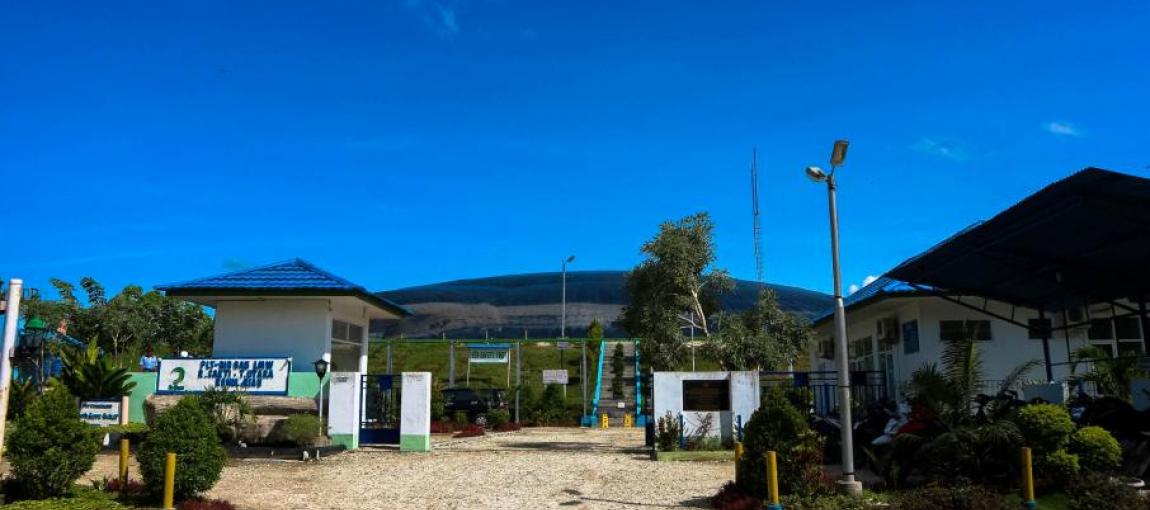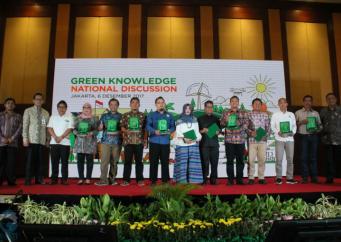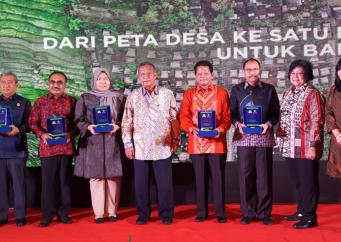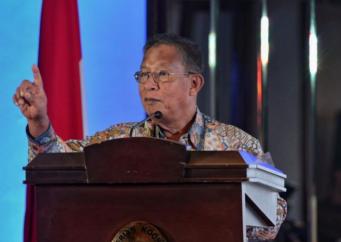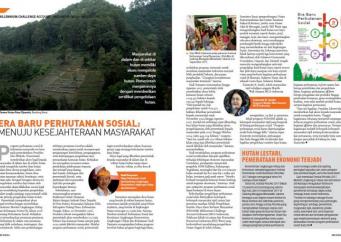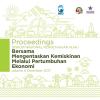PLTBG Rantau Sakti; Limbah Berbahaya Yang Jadi Cahaya
Bangunan itu memang terlihat mencolok. Berada di antara pepohonan sawit, di atas lahan yang luasnya hampir dua hektar. Agak di belakang, sebuah benda hitam membumbung tinggi seperti bukit. Tingginya sekira 10 meter dari tanah, lebarnya 80 m x 90 m, berbentuk trapesium dengan kapasitas 39.000 m3 yang tentu saja sangat menarik perhatian. Bangunan itu adalah reaktor atau pembangkit listrik tenaga biogas (PLTBg) Rantau Sakti yang terletak di Desa Rantau Sakti, Kecamatan Tambusai Utara, Kabupaten Rokan Hulu, Riau.
PLTBg Rantau Sakti resmi beroperasi sejak 2014 dan awalnya melayani 1.050 Kepala Keluarga (KK). Jumlah ini terus bertambah hingga bulan April 2016 jumlahnya sudah mencapai angka 2.232 KK yang bukan hanya berasal dari Desa Rantau Sakti, tapi juga dua desa tetangga.
PLTBg yang menelan biaya lebih dari Rp.20 Miliar ini sebagian besar memang menggunakan dana pemerintah lewat Kementerian Energi dan Sumber Daya Mineral (ESDM), Pemerintah Kabupaten Rokan Hulu serta bantuan swadaya masyarakat. Pemerintah Kabupaten Rokan Hulu mulai membuat pengusulan ke Kementerian ESDM sejak 2010.
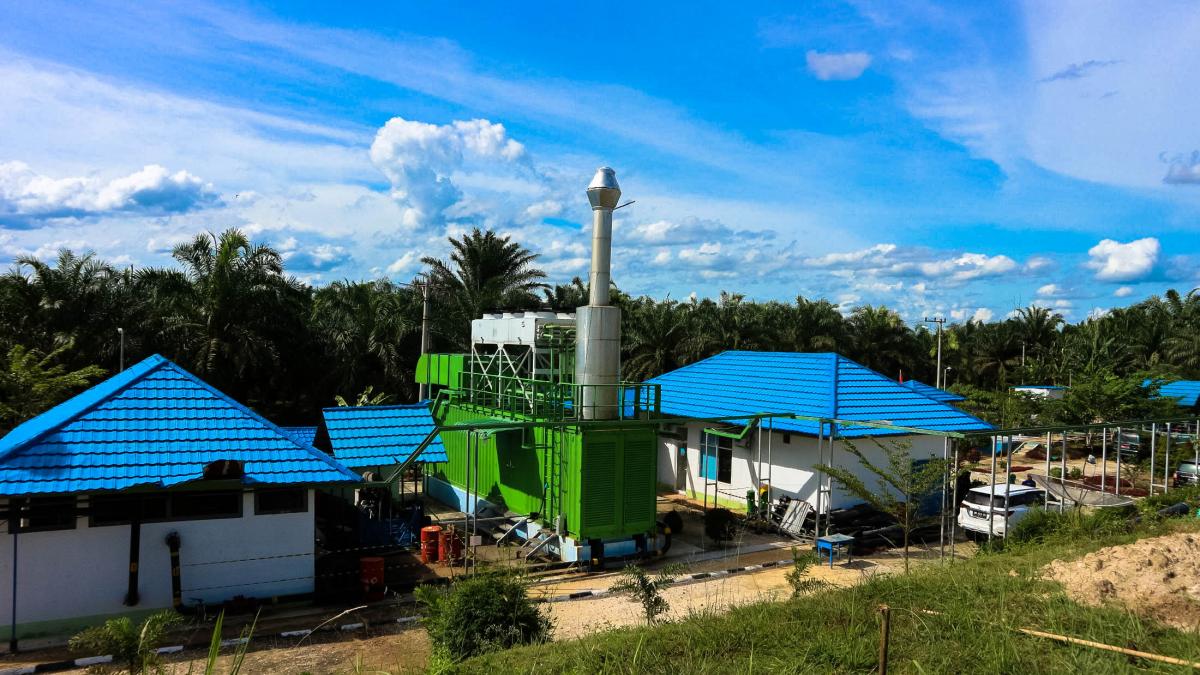
“Waktu itu tingkat elektrifikasi kita memang rendah, daerah Tambusai Utara bahkan masih belum dialiri listrik PLN,” kata . Nifzar, SP. M.Si, kepala Badan Perencanaan Pembangunan Daerah (BAPPEDA) Kabupaten Rokan Hulu.
Nifzar, SP.M.Si kemudian melanjutkan, “Padahal Rokan Hulu punya potensi energi yang sangat besar dari perkebunan sawit. Kita punya 34 pabrik pengolahan kelapa sawit dengan kapasitas 30 ton/jam. Limbahnya dapat dimanfaatkan untuk menghasilkan listrik dengan kapasitas 1 MW.”
Berdasarkan data-data itu, pemerintah daerah Rokan Hulu kemudian mengusulkan ke Kementerian ESDM untuk membangun pembangkit listrik tenaga biogas. Pengusulan tersebut dilakukan mengingat biaya pembangunan yang sangat besar dan sulit ditanggulangi dengan biaya dari anggaran pembangunan dan belanja daerah (APBD).
Pengusulan pertama dilakukan tahun 2010 namun belum beroleh tanggapan. Dua tahun kemudian, Bupati Rokan Hulu kembali mengajukan pengusulan lewat surat bernomor 652/DISTAMBEN- UM/2012 dan masih belum mendapatkan tanggapan. Tanggapan dari Kementerian ESDM baru muncul setahun berikutnya yaitu di tahun 2013.
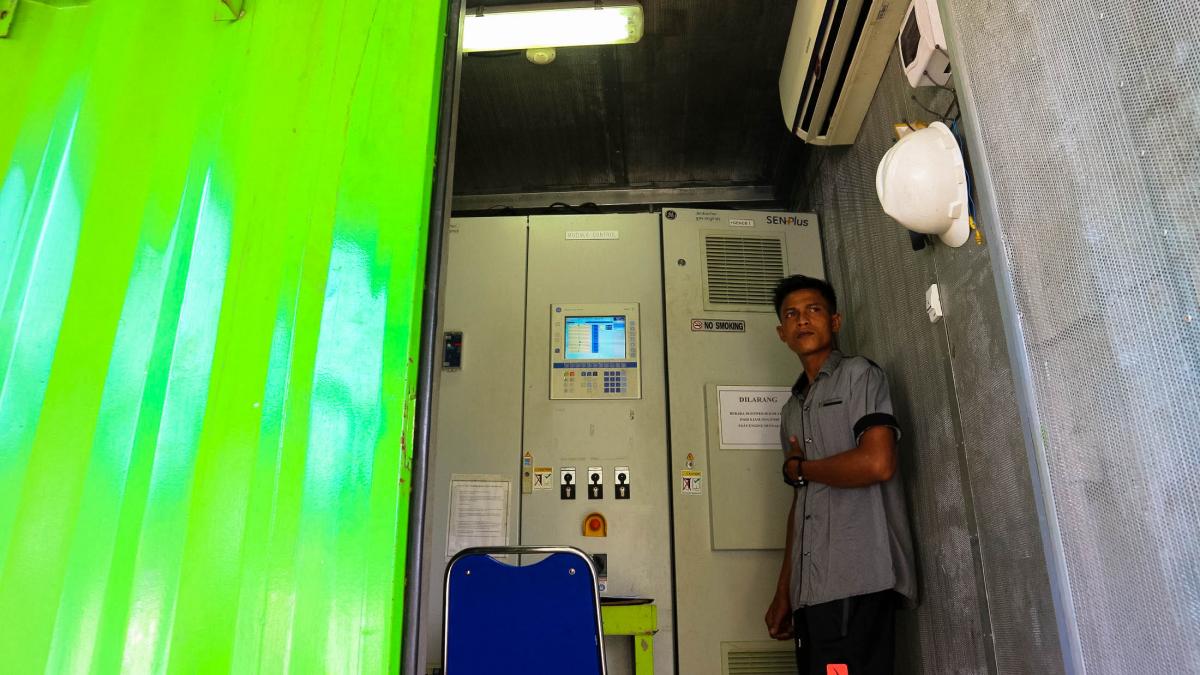
“Kita berangkat dari komitmen pemerintah untuk membuat sebuah pembangkit dalam rangka mengatasi krisis listrik di Rokan Hulu,” kata Drs. Yusmar, M.Si, kepala Dinas Pertambangan dan Energi Kabupaten Rokan Hulu. Kala itu, menurut Drs. Yusmar, M.Si kondisi listrik di Rokan Hulu memang sangat memprihatinkan, ketersediaan listrik berada di bawah 60% dengan voltase yang rendah bahkan sampai di bawah 100 volt. Pemadaman bergilir selama dua jam bahkan lebih adalah makanan sehari-hari bagi mereka.
Lewat berbagai pertimbangan teknis, akhirnya diputuskan bahwa pembangkit listrik tenaga biogas akan dibangun di desa Rantau Sakti. Salah satu faktornya adalah kesiapan warga dan aparat desa untuk ikut membantu pembangunan PLTBg serta ketersediaan lahan dan keberadaan pabrik kelapa sawit (PKS).
Komitmen lain yang didapatkan pihak Pemda Rokan Hulu adalah dari salah satu perusahaan kelapa sawit bernama PT. Arya Rama Prakasa yang bersedia menghibahkan pome (limbah kelapa sawit) selama 20 tahun tanpa imbalan apapun.
Proyek pembangunan PLTBg Desa Rantau Sakti ini adalah pilot project yang menurut Drs. Yusmar, M. Si sesuai dengan pelaksanaan Peraturan Menteri ESDM No.10 tahun 2012 tentang pelaksanaan pembangunan fisik energi baru dan terbarukan. Pembangunannya pun diklaim sebagai usaha untuk mendorong pengembangan desa mandiri energi dan usaha pemerataan pembangunan infrastruktur energi di daerah terpencil.
Dalam masa setahun, pembangunan akhirnya selesai dan PLTBg Rantau Sakti bisa beroperasi. Peran serta masyakarat dalam pembangunan PLTBg Rantau Sakti tidak bisa dibilang kecil. Masyarakat melalui aparat desa Rantau Sakti menyumbangkan tanah seluas 1,5 Ha atau setara dengan nilai Rp. 450.000.000,- sebagai lahan untuk pembangunan PLTBg.
“Mau bagaimana lagi? Ini komitmen kita untuk kesejahteraan masyakarat,” kata Purwadi, kepala desa Rantau Sakti.
Selain itu, sebagai bentuk komitmen dari pemerintah kabupaten Rokan Hulu adalah di awal menyiapkan jaringan tegangan menengah (JTM) dan jaringan tegangan rendah (JTR) senilai Rp.4 5 miliar serta swadaya dana pengelolaan dan pengoperasian PLTBg Rantau Sakti.
Secara sederhana, cara kerja PLTBg Rantau Sakti adalah sebagai berikut: limbah pengolahan kelapa sawit dialirkan dari PKS ke reaktor melalui sebuah pipa. Limbah itu kemudian diolah hingga menghasilkan gas methan yang dihimpun dalam sebuah reaktor yang ditutup oleh plastik. Reaktor ini cukup besar, lebarnya 100 80 m x 90 m dengan ketinggian bubungan mencapai 10 meter dari tanah. Gas yang dihasilkan dari reaktor itu kemudian dialirkan ke sebuah mesin yang bertugas memilah gas yang akan menjadi bahan bakar pembangkit listrik. Listrik yang dihasilkan itulah yang kemudian dialirkan ke rumah-rumah penduduk.
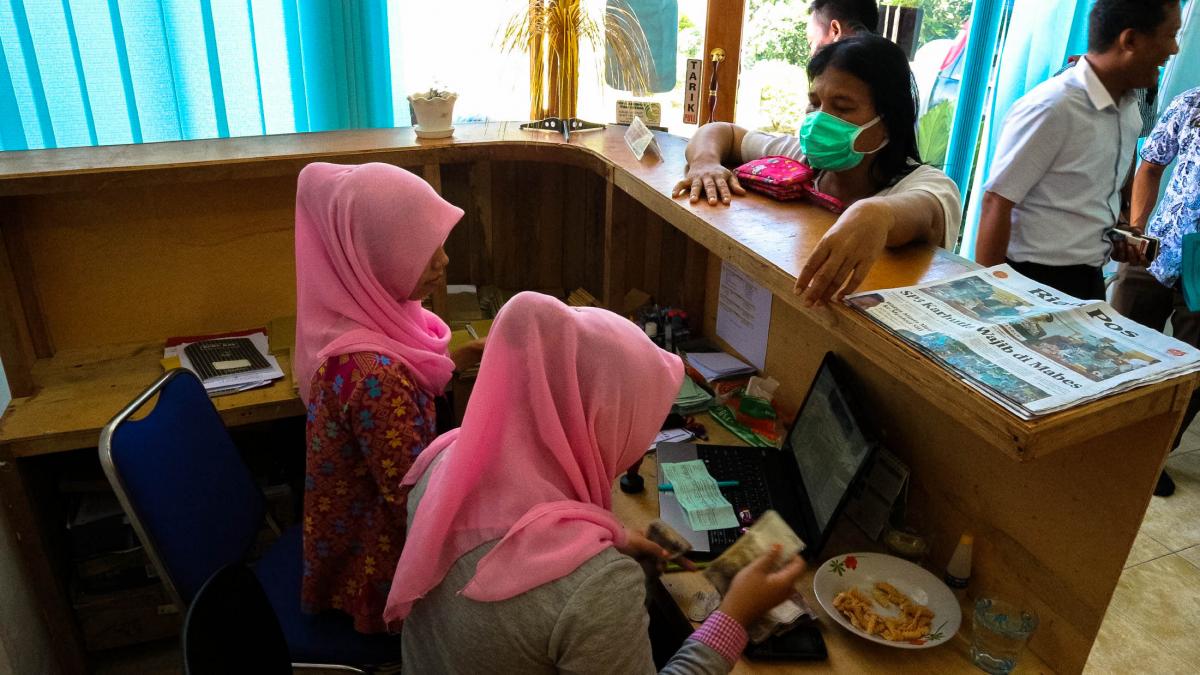
Status Yang Belum Terang
Setelah PLTBg Rantau Sakti resmi beroperasi, Kementerian ESDM lewat Direktorat Jenderal Energi Baru Terbarukan dan Konservasi Energi (EBTKE) kemudian menyiapkan berita acara serah terima kepada Bupati Rokan Hulu lewat surat bernomor: 030/UN-DISTAMBEN/864 Tanggal 16 September 2014. Surat itu kemudian ditindaklanjuti oleh Bupati Rokan Hulu dengan menyerahkan pengelolaan kepada kepala desa Rantau Sakti lewat surat bernomor: 540/DISTAMBEN-UM/525/2014 Tanggal 27 Oktober 2014. Surat ini sekaligus memberi wewenang kepada kepala desa Rantau Sakti untuk menindaklanjuti pengelolaan PLTBg Rantau Sakti.
Kepala desa Rantau Sakti pun merespon dengan membuat surat penetapan pembentukan tim pengelola sementara bernomor: 24 tahun 2014 Tanggal : 24 Desember 2014. Dengan demikian untuk sementara PLTBg dikelola oleh Badan Usaha Milik Desa (BUMDes) Rantau Sakti.
Rangkaian penyerahan PLTBg Rantau Sakti ini ternyata menyisakan kendala tersendiri di lapisan bawah atau pelaksana. Menurut peraturan daerah yang baru saja mengalami perubahan, hibah seperti itu harusnya diturunkan minimal sampai ke Badan Usaha Milik Daerah (BUMD) tingkat kabupaten, bukan tingkat desa seperti yang terjadi pada PLTBG Rantau Sakti.
“Mau tidak kementerian menjamin kalau BUMDES ini disamakan dengan BUMD? Sampai sekarang mereka belum bisa menjawab,” kata Drs. Yusmar, M.Si. Salah satu yang menjadi pertanyaan adalah, bisakah BUMDes mengelola aset bernilai puluhan miliar tersebut?
Dalam kondisi yang seperti ini, Dinas Pertambangan dan Energi Rokan Hulu mengaku belum melakukan audit keuangan terhadap operasional PLTBg Rantau Sakti. Untuk sementara pihak BUMDES Rantau Sakti masih diberi kekuasaan sepenuhnya untuk mengelola meski tetap diminta untuk membuat laporan.
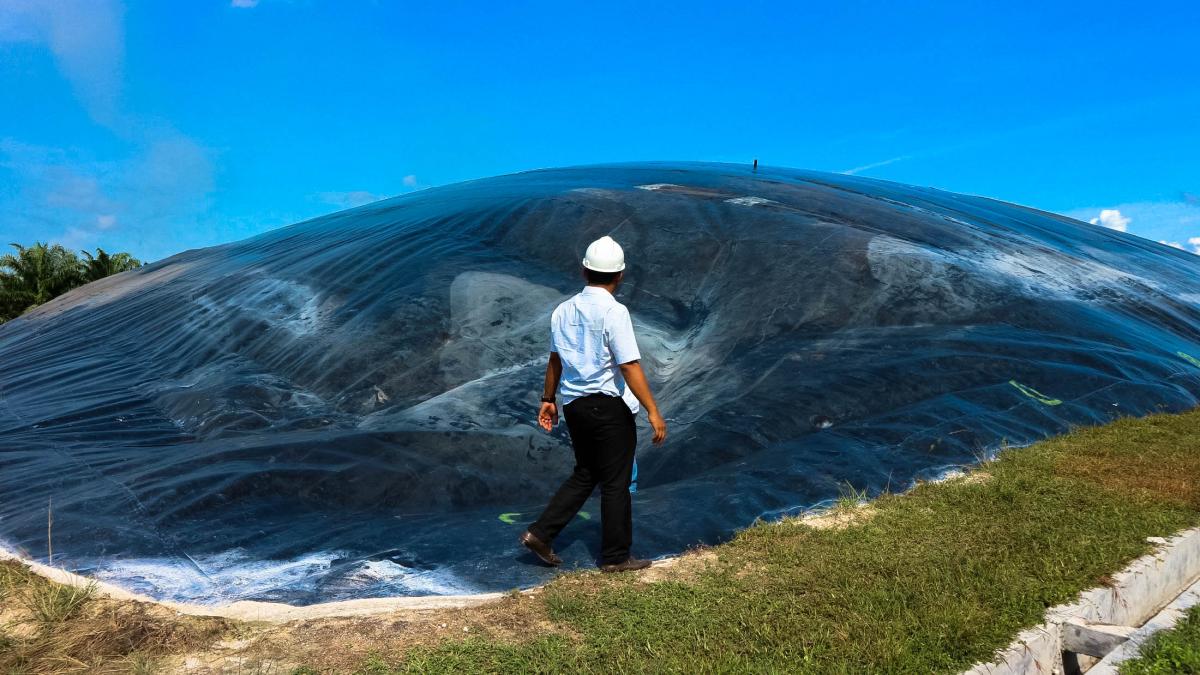
Kesimpangsiuran ini juga diakui sebagai salah satu kendala oleh pelaksana operasional PLTBg Rantau Sakti. Purwadi, kepala desa Rantau Sakti yang sekaligus adalah penanggungjawab PLTBg Rantau Sakti juga mengungkapkan hal yang sama. Menurutnya status PLTBg Rantau Sakti yang belum terang ini cukup menyulitkan mereka sebagai pengelola untuk mengambil langkah-langkah yang dianggap penting. Salah satunya adalah menyiapkan mesin cadangan yang akan membantu mesin yang beroperasi sekarang.
“Mesin yang sekarang sudah dua tahun bekerja non stop. Tingkat kematian listrik kita dalam sebulan tidak lebih dari 24 jam. Kita harus bersiap-siap, usia mesin kan maksimal lima tahun, jika waktunya sudah sampai dan kita belum punya mesin cadangan, bagaimana nasib PLTBg ini?” ujar Purwadi.
Biaya penyediaan mesin cadangan yang dimaksud bukan biaya kecil. Minimal pengelola harus menyediakan paling kurang Rp.7,2 miliar. Dana ini tentu saja tidak bisa didapatkan begitu saja dengan cara menaikkan biaya listrik kepada pelanggan, misalnya.
“Sebenarnya kita bisa saja melakukan kerjasama dengan investor. Sudah ada beberapa investor yang tertarik. Tapi bentuk kerjasamanya bagaimana? Status kita belum jelas,” kata Jaya Lingga Prasetyo, General Manager PLTBg Rantau Sakti.
Sampai sekarang PLTBg Rantau Sakti memang belum mempunyai SIUP dan SITU sehingga mereka sama sekali tidak bisa melakukan apa-apa untuk mendukung pengembangan PLTBg Rantau Sakti.
“Untuk pinjam ke bank Rp.10 juta saja kita tidak bisa. Legalitas kita belum ada,” kata Jaya Lingga Prasetyo lagi.
Ketidakjelasan status ini mungkin saja terjadi karena PLTBG Rantau Sakti adalah pilot project yang mungkin di awal belum dibayangkan akan berjalan sempurna seperti sekarang. Karena pilot project maka bisa saja segala urusan legalitas dan payung hukumnya belum dipikirkan secara mendetail. Untuk menghibahkan secara penuh kepada pemerintah daerah juga bukan hal mudah, Kementerian ESDM harus meminta persetujuan dari Kementerian Keuangan dan presiden Republik Indonesia, mengingat nilai asetnya yang di atas Rp. 10 miliar.
Kemandirian Energi Berkelanjutan
Meski mengaku masih kebingungan di sisi administrasi dan kejelasan status, pengelola PLTBg Rantau Sakti tidak patah semangat. Hingga saat ini mereka terus mengelola PLTBg Rantau Sakti secara profesional. Struktur organisasi jelas, pengelola dan penanggungjawab juga jelas dan operasional berjalan seperti layaknya sebuah usaha profesional.
Semua ini adalah bentuk komitmen pengurus kepada masyarakat, khususnya yang sudah menikmati listrik dari PLTBg Rantau Sakti. Meski begitu, menurut Purwadi warga awalnya sempat curiga. Keterangan awal yang diterima mereka listrik PLTBg Rantau Sakti adalah sumbangan dari kementerian, tapi kenapa mereka tetap harus membayar listrik per bulan? Setelah diterangkan barulah mereka mengerti kalau untuk operasional mereka tetap harus membayar meski harganya jauh lebih murah dari harga listrik PLN. Untuk satu kWh warga hanya dibebani biaya Rp.1.900,-, jauh lebih murah dari harga listrik jika masyarakat menggunakan PLTDyang mencapai Rp.4.000,-/kWh.
“Kalau soal manfaat tidak usah ditanya lagi, listrik di sini sudah tidak sekadar buat kehidupan sehari-hari tapi juga untuk kebutuhan usaha,” kata Purwadi.
Selain listrik, limbah dari PLTBg juga ternyata bisa dimanfaatkan sebagai pupuk cair organik. Saat ini, produksi pupuk organik yang dihasilkan oleh PLTBg sudah mencapai angka 8.000 liter per hari, padahal permintaan sudah mencapai 12.000 liter per hari. Ini yang disebut Jaya Lingga Prasetyo sebagai kemandirian energi yang berkelanjutan.
“Hasil dari kebun kelapa sawit diolah oleh perusahaan menjadi beberapa produk, limbahnya kami ambil untuk menjadi bahan bakar biogas di PLTBg. Hasilnya menjadi listrik untuk warga, nah limbahnya lagi kita olah menjadi pupuk yang bisa dimanfaatkan petani untuk menyuburkan kelapa sawit mereka,” terang Jaya Lingga Prasetyo.
Belum jelasnya status pengelolaan PLTBg Rantau Sakti memang masih jadi satu kendala yang cukup mengganjal bagi pengelola. Namun, itu tidak menyurutkan niat mereka untuk terus menjaga, merawat dan mengelola PLTBg Rantau Sakti. Sebagai pilot project, PLTBg Rantau Sakti bisa dianggap berhasil. Selain memanfaatkan limbah berbahaya yang merupakan energi baru dan terbarukan, mereka pun memberi bukti bahwa desa juga bisa mandiri energi termasuk mandiri dalam pengelolaannya.
Slogan “limbah berbahaya menjadi cahaya” yang digunakan oleh Dinas Pertambangan dan Energi Rokan Hulu bukan tanpa alasan. Dengan slogan itu mereka memberi bukti, limbah sawit yang dianggap berbahaya toh bisa juga diolah menjadi cahaya yang menerangi warga.
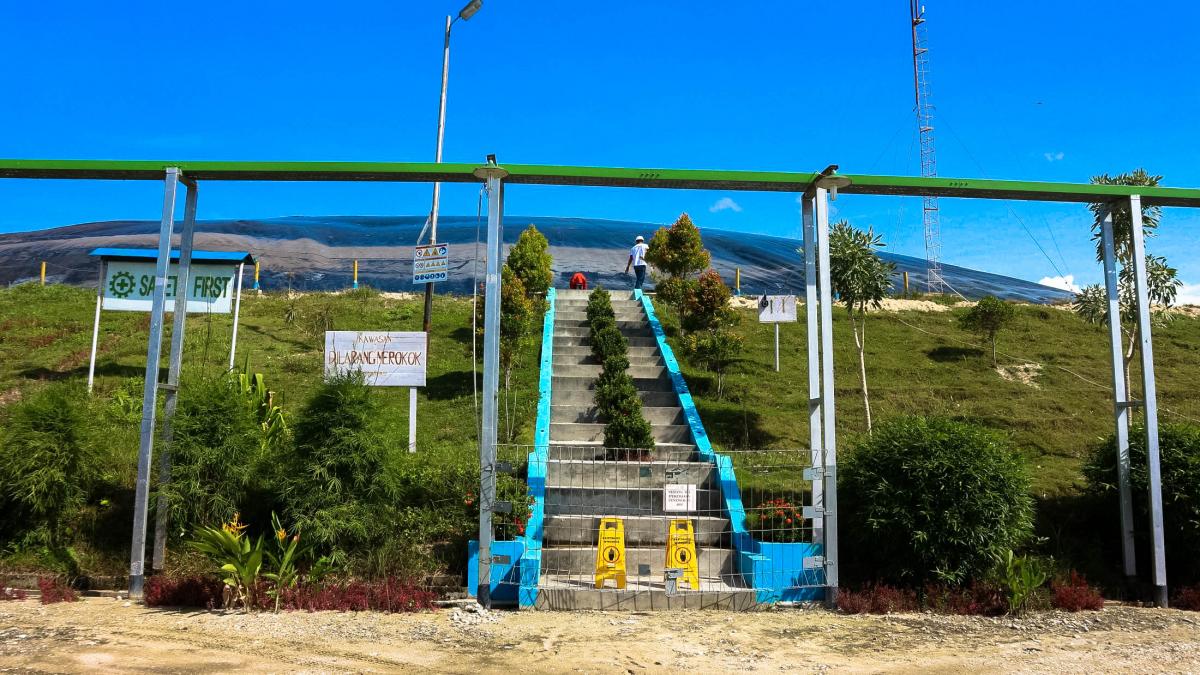
----------------------------------------------------------------------------------------------------------------------------------------------------------------------------------------------------------
Biogas Power Plant (PLTBg) of Rantau Sakti; When Hazardous Waste Turns into Light
That building does look striking. It situates between the palm trees on an almost two hectares land area. A black object soars resembling a hill on the back of the trees. That black object is approximately 10 meters in height from the ground with a 80 m x 90 m width in a shape of a trapezoid. Additionally, it is evident that an object with a size capacity of 39,000 m3 will attract some public attention. This building is a reactor or a biogas power plant (pembangkit listrik tenaga biogas) or PLTBg of Rantau Sakti, which is located in the village of Rantau Sakti, North Tambusai Sub-District, Rokan Hulu District of the Riau Province.
PLTBg of Rantau Sakti was officiated in 2014 and was initially served 1,050 households. This number has been consistently increasing up to serving 2,232 homes by April 2016. These households are not only from the village of Rantau Sakti, as the coverage of the biogas power plant has also reached to serve the other two neighbouring villages.
The biogas power plant has cost for more than Rp. 20 billion from government funding through the Ministry of Energy and Mineral Resources (ESDM), the District Government of Rokan Hulu and community funding. The District Government of Rokan Hulu had started its first funding proposal to the Ministry of Energy and Mineral Resources since 2010.
“At that time our power capability was very small, as some areas in North Tambusai was not even provided with any electricity,” says Nifzar, SP., M.Si, Head of Regional Development Planning Board (BAPPEDA) of Rokan Hulu District.
Nifzar, SP., M.Si further explained, “The fact is, Rokan Hulu District has a significant energy potential from the palm trees plantation. We currently have 34 palm processing factories with 30 tonnes per hour capacity. The waste of the factory can be utilised to produce electricity power with a 1 megawatt capacity.”
Based on these facts, district government of Rokan Hulu would then formulate a proposal to the Ministry of ESDM to establish a biogas power plant in the area. This proposal to the Ministry of ESDM was drafted and submitted considering the significant funding it required for the construction of the power plant, as the district budget would not have been able to secure the funding.
The first proposal was submitted in 2010 without further response. The next two years, the Head of District of Rokan Hulu submitted the proposal for the second time through an official letter number 652/DISTAMBEN – UM/2012, which also resulted in no response. A reply of the Ministry of ESDM was eventually issued in the subsequent year of 2013.
“Our underlying basis is derived from the commitment by the government to establish a power plant to solve an electrical power crisis in the district of Rokan Hulu,” said Drs. Yusmar, M.Si, Head of Dinas of Mining and Energy of the Direct of Rokan Hulu. At the given time, according to Drs. Yusmar, M.Si, electrical power condition in Rokan Hulu was severely alarming, as the power supply was below 60% with a low voltage, even reaching to below 100 volts. Periodically, rolling blackouts were imposed for two hours or more in a day, presents itself a common condition which had been customised to the local people of Rokan Hulu.
Under various technical considerations, a decision was made to construct a biogas power plant in the Rantau Sakti village. One of the leading factors was the commitment and readiness of the local people and officials to assist the PLTBg construction, in addition to land availability for the power plant and a palm oil factory in the proximity of the area.
The District Government of Rokan Hulu also had acquired another commitment from one of the palm oil companies by the name PT. Arya Rama Prakasa, who were willing to give their POME (palm oil mill effluent) or palm oil waste for twenty years time without any additional charge.
Construction of PLTBg of Rantau Sakti village constitutes a pilot project which according to Drs. Yusmar, M.Si is in line with the implementation of the Minister of ESDM Regulation No. 10 Year 2012 on the physical development of the new and renewable energy. The construction is also deemed as an effort to encourage the development of energy-independent village and strategy for equitable energy infrastructure development in remote areas.
Within one year, the construction was completed and PLTBg of Rantau Sakti was ready to operate. The role and contribution of the community in the development of the PLTBg Rantau Sakti has been crucial. The community through village officials of Rantau Sakti have contributed a land area of 1.5 ha or equivalent of Rp. 450,000,000 as the site for the construction of the biogas power plant.
“What can we say? This is our commitment to the welfare of the community,” says Purwadi, The Head of The Rantau Sakti Village.
In addition, as a form of commitment from the district government of Rokan Hulu at the initial stage of the power plant, it has secured a medium voltage network (jaringan tegangan menengah or JTM) and low voltage system (jaringan tegangan rendah or JTR) with an equivalent value of Rp. 5 billion as well as self-help funding to manage and operate the PLTBg of Rantau Sakti.
In hindsight, the operation of PLTBg of Rantau Sakti is described as follow: palm oil processing waste is discharged from the factories to the installed reactor through pipes. Waste is then processed to produce methane gas collected in a reactor that was closed by plastic. This reactor is quite large, with a size of 80 m x 90 m in width and a ridge height reaching 10 meters from the ground. The gas produced from the reactor is now being flowed into a machine in charge of sorting out gas that will eventually fuel the power plant. The electricity power generated from the biogas power plant is being streamed to people’s homes.
Unclarified Status
After the official operation of PLTBg of Rantau Sakti, Ministry of ESDM through Directorate General of Renewable Energy and Energy Conservation (EBTKE) then prepared a formal transfer report to the Head of District of Rokan Hulu through a formal letter of 030/UN-DISTAMBEN/864 on 16 September 2014. This letter was then followed-up by Head of District of Rokan Hulu by handing the management over to the Head of Rantau Sakti Village through an official letter of 540/DISTAMBEN-UM/525/2014 on 27 October 2014. This letter also authorises the Head of Rantau Sakti Village to officially taking over the operation of the PLTBg of Rantau Sakti.
The Head of Rantau Sakti Village responded the letter by issuing the letter for the establishment of temporary management team. This letter was numbered 24/2014 on 24 December 2014. Thus, for a temporary basis, PLTBg is being managed by Village-owned enterprise (Badan Usaha Milik Desa or BUMDes) of Rantau Sakti.
This series of handover mechanism for PLTBG of Rantau Sakti has brought itself a particular set of obstacles in the actual implementation. According to the local regulation which had just been revised, this type of grant should be handed over in the level of District-owned enterprise (Badan Usaha Milik Daerah tingkat Kabupaten). The management should not be handed over to the village level as it had occurred in the case of PLTBg of Rantau Sakti.
“We should ask whether the Ministry could ensure that BUMDes is legitimately similar to BUMD? We have not acquired any response from there regarding this matter,” said Drs. Yusmar, M.Si. One of the fundamental question on this is, could BUMDes manage an asset with a total value of billions of rupiah?
On this particular circumstance, Dinas of Energy and Mining of Rokan Hulu District has acknowledged that it has yet to conduct a financial audit on the management of PLTBg of Rantau Sakti. For the time being, BUMDes of Rantau Sakti has the legitimate authority to manage and operate the power plant, although they are required to submit management reports.
This particular uncertainty was admitted of becoming a hindrance for the operational management of PLTBg of Rantau Sakti. Purwadi, Head of Rantau Sakti Village, who also assume the person-in-charge for the PLTBg Rantau Sakti have conveyed a similar statement. According to him, the unclear status of PLTBg of Rantau Sakti has provided them with certain constraints when it comes to making critical decisions. One of them was the decision to secure a backup engine to assist the currently operating engines.
“Our current machine has been in non-stop operation for two years. Our blackout rate within a month is not more than 24 hours. We need to be prepared, as maximum usage of this machine is within 5 years time, which is this year, and we have not secured a backup machine. We need to think this thoroughly for the longevity of this PLTBg,” says Purwadi.
However, the procurement cost for the backup engine is not cheap. The management team has to secure a minimum of Rp. 7.2 billion to purchase the machine. To get the funding to cover this cost should not be imposed on the public by suddenly increasing their power bills.
“In truth, we can establish a collaboration with an investor. We currently have several investors showing their interests. However, we are unclear about the mechanism. Our status is still unclear,” said Jaya Lingga Prasetyo, General Manager of PLTBg of Rantau Sakti.
PLTBg of Rantau Sakti still has not equipped with SIUP and SITU. Therefore they still cannot do anything to support the further progress and development of PLTBg of Rantau Sakti.
“We cannot even go to the bank and ask for Rp. 10 million loans. Our legality as an entity has not been clarified,” said Jaya Lingga Prasetyo further.
This occurring unclarity might have been contributed by the fact that the initial vision of the PLTBg Rantau Sakti as a pilot project which might not have been running perfectly as it is now. Due to the fact that it was being visioned as a pilot project, the legality spectrum of this entity was not thoroughly conceived in details. In truth, with regards to donating budget to the local government was not an easy matter, as the Ministry of ESDM must seek approval from the Ministry of Finance and the President of the Republic of Indonesia, considering the asset value of this power plant is above Rp. 10 billion.
The independent renewable energy
Although acknowledging the confusion on the administration and the legality aspects, the management of PLTBg of Rantau Sakti remains confident. They still operate the PLTBg as of today in a professional manner. Their organisation structure is evident, as well as their management team which has been operating professionally.
This is a form of strong commitment of the management team to the public, especially those who have consumed the electrical power produced by PLTBg of Rantau Sakti. However, Purwadi also admits that several members of the community was initially suspicious of the power plant. Some of them testified that they were initially told that the electrical power from PLTBg of Rantau Sakti was in the form of donation from the Ministry, but they were suspicious on why they still have to pay the monthly bill. They were then briefed that these charges are being contributed to the operational aspect of the power plant, and that the amount of payment is far lower than the electricity from the National Power Company (PLN). For one KWh, people will have only to pay Rp. 1,900,-, this is far less than the price from PLTD, which reaches to Rp. 4,000 per KWh.
“When it comes to the benefit, it is inarguable that the electricity is not only beneficial to their daily lives but also for the needs of their economic endeavours,” said Puwadi.
In addition to electrical power, the waste from PLTBg could also be used as liquid organic fertiliser. Currently, liquid organic fertiliser produced by PLTBg is reaching to 8,000 litres per day, where in reality the demands have reached to 12,000 per day. This is what Jaya Lingga Prasetyo called independent sustainable energy.
“Production of palm trees by the factories and companies will result in several products, and their waste is allocated for the biogas fuel of PLTBg. The result of this biogas power plant is streamed to the public, and the waste of this power plant is being utilised by the farmers to fertilise their palm trees,” said Jaya Lingga Prasetyo.
The unclarity status of PLTBg of Rantau Sakti when it comes to its management has indeed brought itself a challenge for the operation team. However, it does not present itself as a challenge to maintain, operate and manage the biogas power plant. As a pilot project, PLTBg of Rantau Sakti has been considered successful. In addition, to utilise hazardous waste as renewable energy, they also have proven that a village can be independent when it comes to renewable energy, including establishing independent management team.
The slogan of “Turning Hazardous Waste into a Light” has been promoted by the Dinas of Mining and Energy of Rokan Hulu. This slogan has provided them with legitimate proof that hazardous element can be processed and managed into light and solution to the local people.

